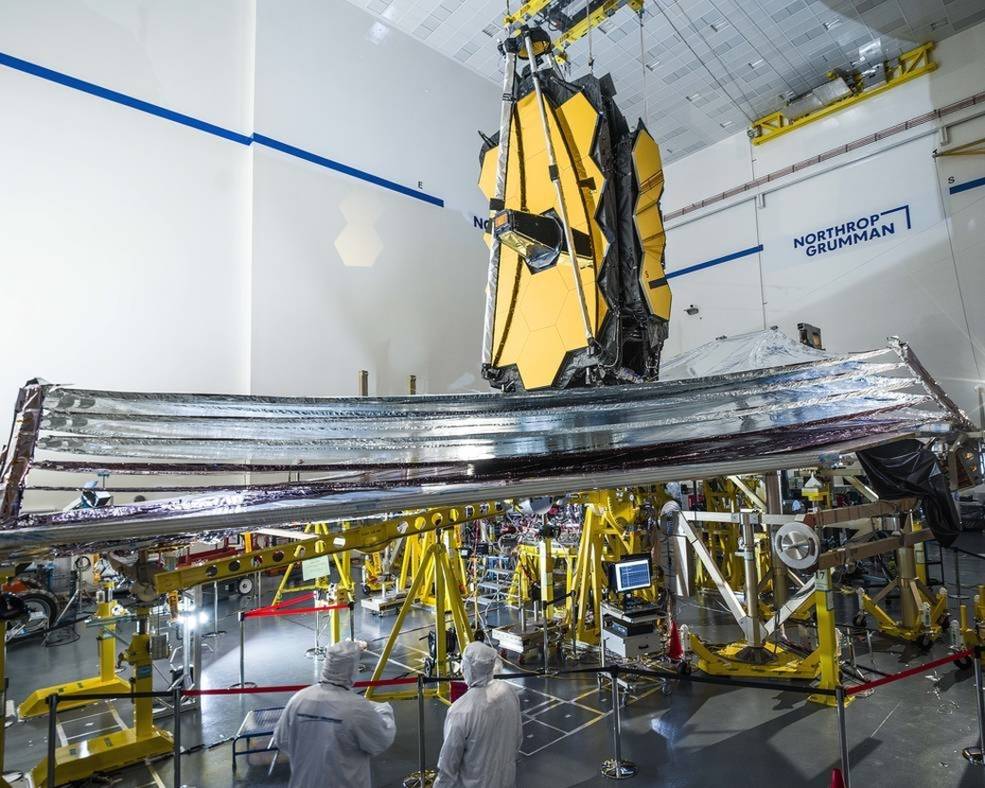
“The James Webb Space Telescope team has fully deployed the spacecraft’s 70-foot sunshield, a key milestone in preparing it for science operations.
The sunshield – about the size of a tennis court at full size – was folded to fit inside the payload area of an Arianespace Ariane 5 rocket’s nose cone prior to launch. The Webb team began remotely deploying the sunshield Dec. 28, 2021, three days after launch.
NASA will hold a media teleconference at 12:45 p.m. EST today, Tuesday, Jan. 4, to discuss the completion of this critical step. To participate by telephone, media must RSVP to Laura Betz at: laura.e.betz@nasa.gov. Audio of the teleconference will also stream on the agency’s website.
“This is the first time anyone has ever attempted to put a telescope this large into space,” said Thomas Zurbuchen, associate administrator for NASA’s Science Mission Directorate at the agency’s headquarters in Washington. “Webb required not only careful assembly but also careful deployments. The success of its most challenging deployment – the sunshield – is an incredible testament to the human ingenuity and engineering skill that will enable Webb to accomplish its science goals.”
The five-layered sunshield will protect the telescope from the light and heat of the Sun, Earth, and Moon. Each plastic sheet is about as thin as a human hair and coated with reflective metal, providing protection on the order of more than SPF 1 million. Together, the five layers reduce exposure from the Sun from over 200 kilowatts of solar energy to a fraction of a watt.
This protection is crucial to keep Webb’s scientific instruments at temperatures of 40 kelvins, or under minus 380 degrees Fahrenheit – cold enough to see the faint infrared light that Webb seeks to observe.”
https://www.nasa.gov/press-release/sunshield-successfully-deploys-on-nasa-s-next-flagship-telescope

Early fall should be getting amazing pics. Takes a while for it to cool off in space. I have yet to hear the layman analogy compared to the Hubble. Assuming it’s like going from the early brick cell phone in Elvis’s car to a modern day smart phone? No idea.
Sounds like a good analogy: it has a suite of instruments, some of which can be used concurrently (multitasking), the processing power must be several orders of magnitude greater, and it is nearly impossible for the end user to repair unlike previous models!
More like eyeglasses to Giordi L Forge’s (Next Generation) visor – its opening up the spectrum.
Secondary mirror deployment is now complete.
walrus
Que bueno es!
So far so good. NASA’s Webb page “Where is Webb” has a really cool live tracker with lots of info. There are so many cool things that Webb may be able to see more clearly but I am curious to learn what light Webb can shed on the sub-neptune like planets in the TOI-207 system. Also, I hope it can give us better images of the system of Alpha Centauri .
Truly magnificent space observatory.
Following progress as the machine unfolds.
Still a long way to go but system has worked as designed so far.
Been waiting a long time for this to become operational.
A very interesting concept brought to reality. It reminds me of the solar sail idea I first read about in Jerry Pournelle and Larry Niven’s book “The Mote in God’s Eye”. As for non-scifi I hope this doesn’t give any of the mad scientist climate changers and idea of how to cool the Earth! Though I do wonder just how much radiation could be deflected and how big a shield, and at what distance from the planet, it might take.
Mirrors unfolding
Heat exchanger deployed.
About the only news I want to see is about this magnificent machine.
American government is corrupt beyond belief.